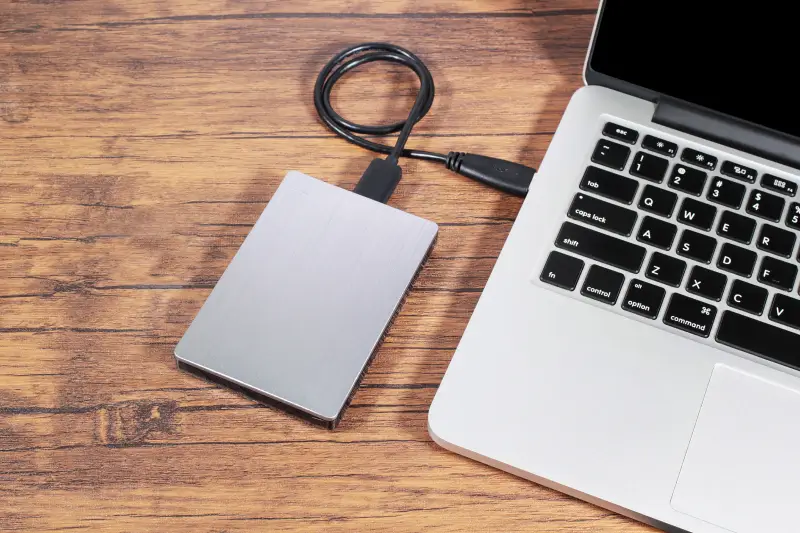Few technical issues are more frustrating than plugging in your external hard drive, only to find that your Mac refuses to recognise it. Whether you're trying to back up files, transfer photos, or access critical work documents, the sudden silence of an unresponsive drive can feel like a disaster waiting to happen. Fortunately, this issue is usually fixable.
Secure Data Recovery, the authority in RAID, SSD, and hard drive recovery, provides solutions for when an external hard drive doesn’t work with macOS. Below, we will walk you through the key troubleshooting steps.
macOS File System Compatibility
One frequent cause of drive failure on macOS is file system incompatibility. While macOS supports several formats, each behaves differently:
- APFS (Apple File System) -Optimised for SSDs and default for newer Macs. Fully supported.
- HFS+ (Mac OS Extended) - The legacy Mac format. Still fully compatible. Ideal for hard disk drives.
- exFAT - Supported by both Windows and macOS. Intended for cross-platform users, but has performance limitations.
- FAT32 - Compatible but limited to 4GB file sizes.
- NTFS - Read-only in macOS. Writing requires third-party drivers.
If your drive is NTFS-formatted, macOS may not mount it, or may only allow read access. You can check the file system using Disk Utility under Applications > Utilities.
Note: Reformatting erases all data. Back up your files first or consult a professional if data recovery is necessary.
Hardware and Connection Issues
Even when a drive is formatted correctly, hardware issues can prevent it from working with macOS.
Common culprits include:
- Damaged cables - Frayed or poor-quality USB or Thunderbolt cables can disrupt data flow.
- Insufficient power -Large HDDs may need external power or powered USB hubs.
- Worn ports - Try switching USB ports or using another Mac.
- Adapter issues - USB-A drives may require USB-C adapters; mismatched ports can cause compatibility issues and failures.
- Partition table errors - macOS prefers GUID Partition Map (GPT). Drives formatted with MBR may not mount.
To check hardware:
- Connect the drive to another Mac or PC.
- Listen for spinning or clicking sounds.
- Open System Information > USB to see if macOS detects it.
If the drive isn’t listed, the problem may be hardware-based.
macOS Security and Privacy Settings
Modern versions of macOS include strict security and privacy features designed to protect users, but these features can sometimes block access to external drives.
System Integrity Protection (SIP)
SIP restricts access to system areas, including those reserved for administrators. Third-party software may be blocked if SIP isn’t configured appropriately. Disabling SIP is not recommended unless absolutely necessary.
T2 Security Chip and External Media Access
Macs with a T2 chip (models from 2018 and later) may block drives unless explicit permissions are granted.
To grant access:
- Go to System Settings, then select Privacy & Security.
- Enable permissions under Full Disk Access and Files and Folders.
- Ensure Finder and Disk Utility are approved.
Newer macOS versions may also request confirmation before mounting. If denied, the drive remains inaccessible until permissions are updated.
Gatekeeper and Software Permissions
Gatekeeper blocks unverified apps, including some encryption or disk management tools. Ensure all necessary software is updated and properly authorised.
Drive Formatting and Mounting Problems
Even if an external hard disk is physically functional and file system–compatible, it may still not appear in Finder. In many cases, the issue lies with how the drive is mounted.
What Does “Mounting” Mean?
Mounting is the process of making a storage device accessible by the operating system. If a drive isn’t mounted, it won’t appear in Finder, even if it’s connected properly.
To check if your drive is detected:
- Open Disk Utility.
- Select the external drive in the left-hand sidebar. A greyed-out device indicates the drive is not mounted.
- Click the drive and select Mount.
Unformatted or Corrupted Drives
If Disk Utility shows the drive but not a usable volume, the disk may be:
- Unformatted: A new drive that hasn’t been initialised.
- Formatted incorrectly: For example, with a Linux file system like ext4.
- Corrupted: Damaged partition tables or file systems can prevent proper mounting.
Use Disk Utility’s First Aid tool to diagnose and repair:
- Select the volume or disk.
- Click First Aid, then Run.
- Wait for macOS to scan and attempt repairs.
Note: Running First Aid could result in sudden data loss if the tool relocates data. Make sure you have copies of data stored on the drive before proceeding.
Third-Party Software Conflicts
macOS typically works well out of the box, but sometimes third-party software can interfere with its interaction with external drives.
- Antivirus/Endpoint protection. May misidentify drives as threats. Try disabling it temporarily.
- Encryption tools. Drives encrypted with BitLocker or proprietary tools may not mount. Install the correct macOS-compatible decryption utility.
- NTFS drivers. Outdated or incompatible drivers can block access. Use verified drivers, such as Paragon NTFS or Tuxera NTFS, and avoid unstable, free alternatives.
Data Corruption and Disk Failure
If your external hard disk still isn’t working after verifying connections, file system compatibility, and security settings, the issue may be more serious.
Common Signs of Physical Failure
- Clicking, grinding, or buzzing noises from the drive.
- The drive doesn’t spin up or power on.
- macOS doesn’t detect the drive in Disk Utility or System Information.
- The drive randomly disconnects or stalls transfers.
These symptoms often indicate mechanical failure in HDDs or controller damage in SSDs. In either case, continued attempts to connect the drive may worsen the damage.
Symptoms of Data Corruption
- The drive appears in Disk Utility but shows uninitialized, unreadable, or unformatted.
- Disk Utility’s First Aid fails or freezes
- Files appear scrambled, renamed, or missing
- File transfer errors or messages such as The disk you inserted was not readable by this computer.
Corruption may occur due to unsafe ejection, power loss, software bugs, or ageing sectors. If valuable data is on the disk, avoid reformatting or using DIY recovery software, which can overwrite recoverable files.
How to Safely Resolve macOS External Drive Issues
When your external hard drive refuses to work with macOS, it’s essential to follow a systematic troubleshooting process.
Troubleshooting Checklist
- Check connections. Swap cables, try another port or Mac, use a powered hub.
- Use Disk Utility. Attempt manual mounting. Run First Aid.
- Verify format. Confirm compatibility (exFAT, APFS, HFS+). Back up before reformatting.
- Review permissions. Grant Full Disk Access. Update Gatekeeper approvals.
- Remove third-party conflicts. Pause antivirus – Uninstall outdated NTFS drivers.
- Test on another system. A PC may help retrieve files or confirm failure.
If your drive shows signs of corruption or failure, avoid writing to it or using free recovery tools. Every failed attempt risks overwriting recoverable data or worsening physical damage.
When to Seek Professional Help for External Drive Recovery
If your external hard disk still won’t work with macOS after following the above steps, the issue may lie beyond basic troubleshooting. Whether you’re facing hardware failure, corrupted file systems, or encrypted volumes that macOS can’t access, continuing DIY attempts can put your data at greater risk.
Secure Data Recovery offers specialised, comprehensive solutions tailored to Macs. Our team ensures a seamless and convenient recovery process for a hassle-free, high-performance data security solution, whether you represent a large corporation, a small business, or an individual.
Don't risk your crucial information. Contact Secure Data Recovery at 800-705-3701 today to speak with external drive recovery experts.











